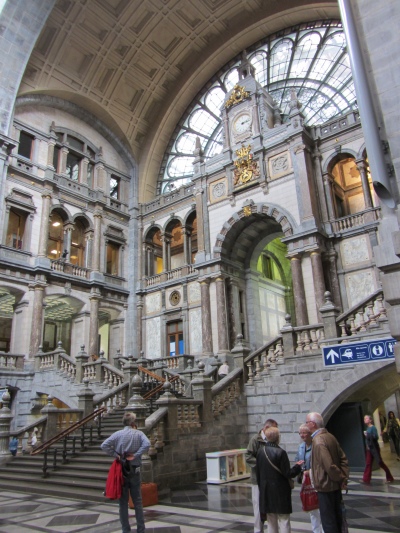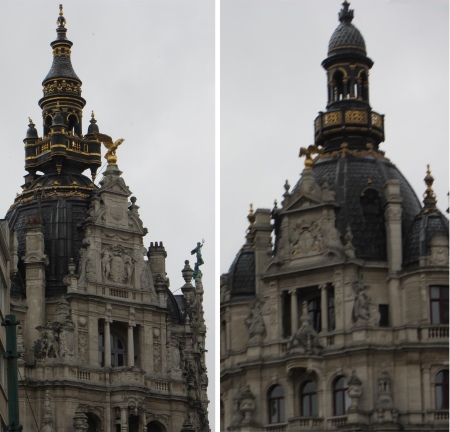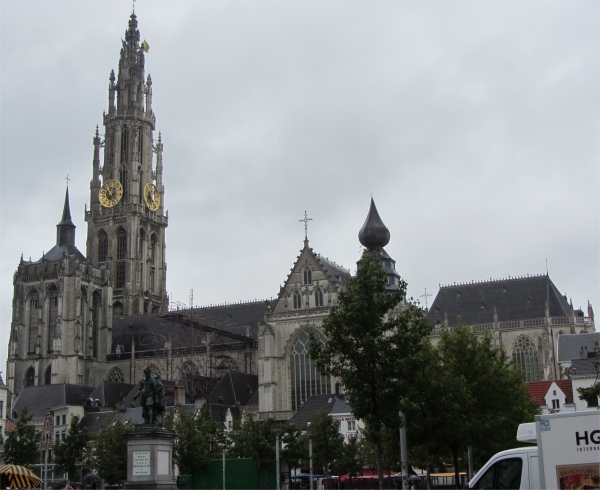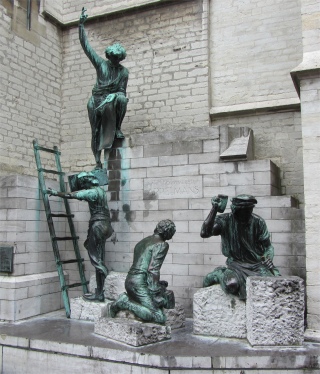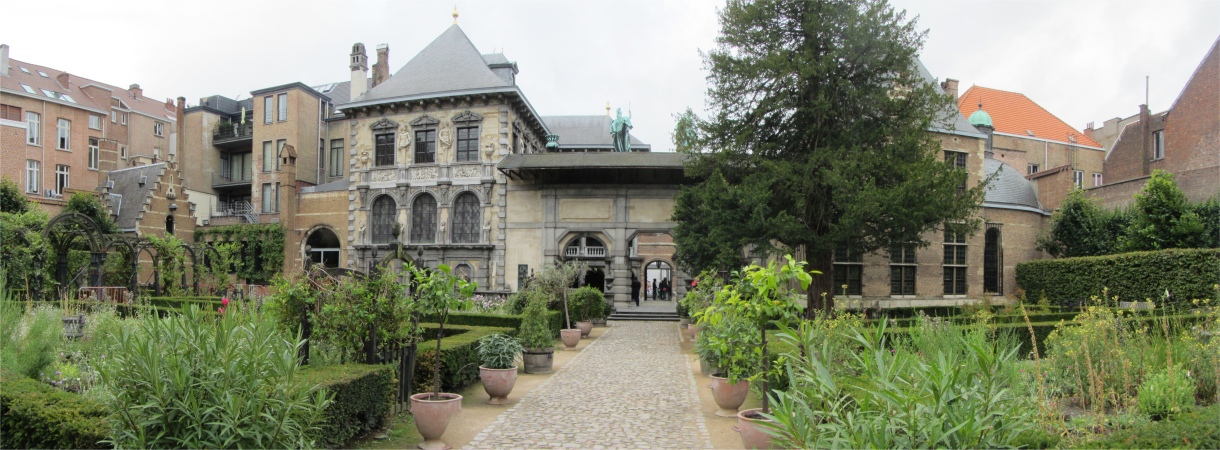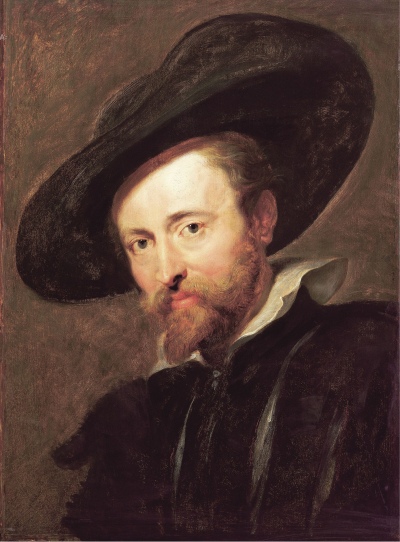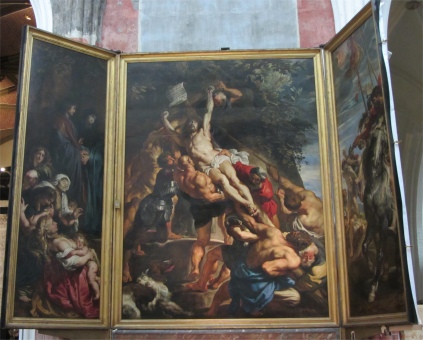
Elevation of the Cross (Rubens 1610)
|
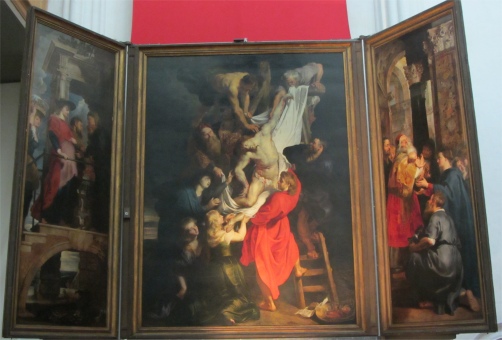
The Decent from the Cross (Rubens 1612-1614)
|
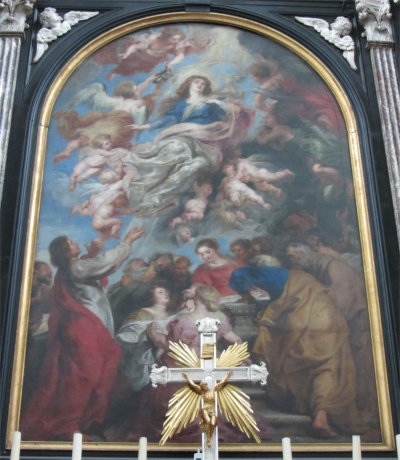
The Assumption of the Holy Virgin (Rubens 1625)
|
As we reached the Meir, the main shopping thoroughfare which appeared to be a shopaholic's heaven, we discovered the summer sales had just started. This explained why so many young folk were heading in from the provinces. Rain was still in the air as we weaved our way through throngs of people dressed in vibrant colours, their out-stretched umbrellas eager to poke out our eyes. The shops were very chic, extremely fashionable, expensive, and exceedingly well frequented.
On arriving at the Groenplaats we were confronted by the largest Gothic church in the Low Countries, the Onze-Lieve-Vrouwekathedral (Cathedral of our Lady), Antwerp's pride and joy. It took some 170 years to build and was completed in 1521. Aptly described as "stone lacework", its 123m northern tower still dominated the skyline. Originally two towers of equal height were planned, but the second tower never emerged. The cathedral was seriously damaged during the French occupation at the end of the 18th century, and most of the interior was sold by the French. Over the last few decades, a lot of restoration work has been done. The cathedral boasted a carillon with 49 bells. We entered and found the sprawling interior defied all sense of scale, a mixture of 17th century baroque and 19th century neo-Gothic. The wide central nave was flanked by three aisles on each side, creating a huge interior space with 48 pillars in each aisle. The nave was bright and airy, steeped in opulent furnishings and drenched by the light passing through colourful stained-glass windows. Despite all the plundering, major art treasuries had survived. The most notable were three large paintings by Rubens:
Descent from the Cross (1612), Elevation of the Cross (1610) and the
Resurrection Triptych (1612). It came as no surprise that the building was on the list of Unesco World Heritage sites.

Stadhuis with Statue of Brabo on the Grote Markt
|
Located just behind the cathedral was the Grote Markt, still the heart of the old city, of a triangular shape originating from the municipal ground created during the era of the Franks. There in the middle of the market stood a statue depicting the protagonist of Antwerp's most famous mythical hero, Brabo, the legendary slayer of the giant. The statue was created by sculptor Jef Lambeaux in 1887.
Behind it, decked out in colourful flags, the Stadhuis (Town Hall) took a commanding position over the Grote Markt. Replacing an older smaller building, the present Stadhuis of Antwerp was built by Cornelis Floris de Vriendt between 1561 and 1565 in Renaissance style, with a touch of Flemish Gothic so as not to contrast too sharply with the surrounding buildings. It needed rebuilding a few years later after being destroyed during the Spanish Fury of 1576. The richly ornamented centre section rose above the eaves in diminishing stages with the statue of the Virgin adorning the central gable. Below stood other statues representing Justice and Prudence, together with the coats of arms of the Duchy of Brabant, the Spanish Habsburgs, and the Margraviate of Antwerp.
Today at least one wedding was being held in the Stadhuis, and outside a large beer marquee was being set up. Nearby, on the wet cobblestones, a pink settee rested, with a patch of carpet beside it and a few stools. The setting was accompanied by a pedestal topped with an ice bucket containing a few bottles of champagne. A light drizzle enveloped the scene, and sadly none of the organisers had the sense to protect the intimate setting. I'm sure the bride and groom would have been delighted to sit on the soggy settee for a photo shoot.
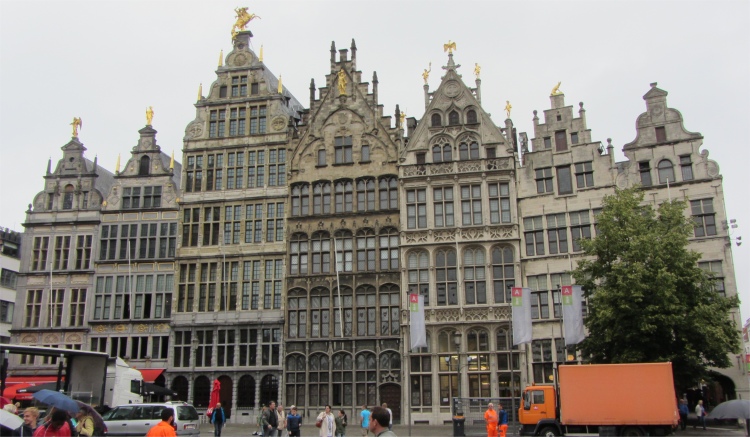
Guild Houses
|
Apart from the Stadhuis most of the buildings bordering the Grote Markt were former "gildehuizen", originally the headquarters of the city's 16th and 17th century guilds. The beautiful houses of the Guilds were unfortunately not the original ones. Similar to the Stadhuis, they were burned down in 1576. Most of the houses were rebuilt afterwards by Hans Vredeman, the town architect, in Flemish Renaissance style. In the 19th century the houses were again renovated, resulting in the current lavishly decorated houses. They reflected the tradition of building in wood with their use of stone to imitate wooden pillars and beams. The group of guild houses on this square were characterized by their variety; each facade striving to be different in height and rhythm. The guild houses featured extensive use of glass, with many windows to let in the maximum amount of light, and were richly decorated with golden statues. Among the houses were: the Gildehuis der Kuipers (Coopers' House; No. 5), the Huis van de Schutters (Archer's House; No. 7) crowned by the statue of St. George, the Huis van de Kruideniers (Grocers' House; No. 11), the Huis van de Kleermakers (Tailors' House; No. 38) and the Huis van de Timmerlieden (Carpenters' House; No. 40).
We ambled down to the Schelde bank, climbed a sharp incline up to a viewing point, and gazed out onto the great river, the massive dock complex further downstream, and a marina partially hidden on the opposite bank.
The Schelde River, also spelt Scheldt, stretched for 435 km, rising in northern France and flowing across Belgium to its North Sea outlet in Dutch territory. Along with the Lower Rhine and the Meuse rivers, it drained one of the world's most densely populated areas. As a waterway, with its numerous branch canals and navigable tributaries, it served an area including the agriculturally important Flanders Plain, the Belgian textile centres, the coalfields of northern France, and the industrial complex of Lille-Roubaix-Tourcoing. The estuary formerly had two channels, the Oosterschelde and the Westerschelde, divided by the islands of Noord, Zuidbeveland, and Walcheren. However, in 1866 the Oosterschelde was sealed off by a dyke carrying the railway to Vlissingen in the Netherlands. The outlet between Zuidbeveland and Walcheren was closed by a dyke, and now the only connection to the Oosterschelde was via Zuidbeveland Canal. Today the river therefore continued into the Westerschelde estuary only, passing Terneuzen to reach the North Sea between Breskens and Vlissingen. A channel in the Westerschelde, with a minimum depth of 7m, allowed ocean-going vessels drawing up to 10m to reach Antwerp at full tide.
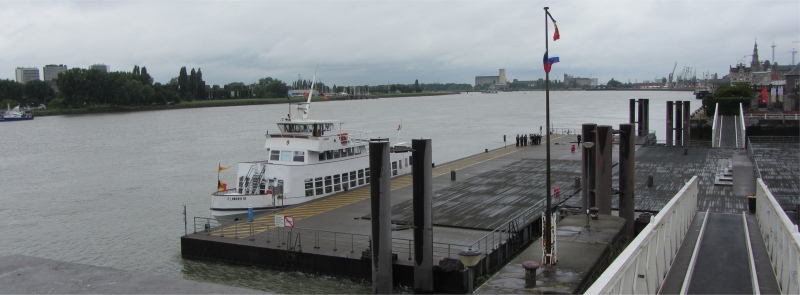
Looking Down Stream Along the Schelde River
|
The Schelde estuary had always been of considerable commercial and strategic importance, and the Schelde once formed the border between France and the Holy Roman Empire. Under Spanish control in 1585, the Dutch Republic took control of Zeeuws-Vlaanderen, a strip of land on the left shore, and closed the Schelde for shipping. This shifted the trade to the ports of Amsterdam and Middelburg and seriously crippled Antwerp. The river was reopened in 1792 during the French Revolutionary era. In World War II the estuary once again became a contested area. Despite allied control of Antwerp, in September 1944 German forces still occupied fortified positions throughout the Schelde estuary west and north, preventing any allied shipping to the port. In the Battle of the Scheldt, the Canadian First Army successfully cleared the area, allowing supply convoys direct access to the port of Antwerp by November 1944.
Those tempestuous times had long been washed away, and now the river slowly and peacefully flowed down to the estuary to meet its destiny in the North Sea. Down below us on a pontoon a gathering of black-suited men stood in pose, waiting for an official wedding photographer to stand them down, when they would be replaced by a group of women in their best dresses, which were starting to cling to them as they slowly got damper.

Het Steen
|
Near our vantage point was Antwerp's castle, known as Het Steen (The Stone), so called because at the time it was built in the 13th century most buildings were still made of wood. The castle was revamped in 1520 under Charles V of Habsburg by the architects Keldermans and De Waghemakere. The statue in front of the castle's gate was once endowed with a conspicuous virile member, but the prude Jesuits disposed of it in the 17th century. Hmm.. perhaps that was chopped off and thrown in the river like the giant's hand. In 1890, The Steen became the museum of archaeology and in 1952 an annex was added to house the museum of Antwerp maritime history, which in 2011 moved to the nearby Museum Aan de Stroom.
We decided not to enter the castle. Rex wanted to visit the Maritime Museum. Meryl, on the other hand, had seen plenty of maritime museums on the trip so far, and had a burning desire to visit the Fashion Museum. I had no desire whatsoever to visit the Fashion Museum, and I was not straining at the leash to visit the Maritime Museum. A marital dispute opened up which I took care not to get dragged in to. "Why don't we just go and do our own thing and meet up at an agreed venue later on?" I suggested. To cut a long story short, Rex decided safety was the better part of valour, and chose to accompany Meryl to the Fashion Museum, and I went off to visit Rubenshuis.
After leaving my companions by the entrance to the Fashion Museum I headed across town towards Wapper Street, passing numerous architectural gems and the Toneelhuis, a merger between the Dutch Royal Antwerp and Blue Monday Companie from Ghent. The Toneelhuis offered two theatres in Antwerp: the 19th century Bourlaschouwburg (ca.900 places) and Cinema Tokyo (about 100 seats).
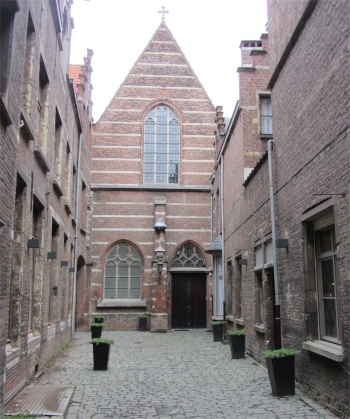
Hidden Church on Way to Rubenshuis
|
In no time at all I was walking down Wapper Street, side stepping noisy groups of school children who were awaiting their next fix of culture therapy, and there it was, surrounded by modern looking buildings, the house of the great man himself, Peter Paul Rubens. He was born in 1577 in Siegen, Germany to Flemish parents. After his father died in 1587, he moved to Antwerp with his mother in 1589. During his youth he studied Latin and classic literature, and painting under Antwerp's leading painters of the time, and at the age of 21 he became a master painter. In 1600, during early adulthood, Rubens travelled to Italy where he studied and became influenced by the Italian masters of the time, as well as by the many traces of antiquity, all of which played a decisive role in his development as a painter. After the death of his mother in 1608, he returned to Antwerp. He remained in Antwerp, where he achieved his breakthrough almost immediately and became the most important artist of his generation.
In 1610 Rubens and his wife, Isabella Brant, bought a house and piece of land on the Wapper, what is now the Rubens House. He had the building enlarged after his own design, adding a covered, semi-circular statue gallery, a studio, a portico in the style of a triumphal arch, and a garden pavilion. The improvements gave his home the air of an Italian palazzo and embodied Rubens's artistic ideals: the art of Roman Antiquity and the Italian Renaissance. He also assembled an internationally admired collection of paintings and classical sculpture at the house.
Rubens lived and worked here, not only as a painter, but also as a diplomat, designer of tapestries, architect, maker of prints and illustrations for books, collector, etc. These activities reached a peak during the decade beginning in 1620, when Rubens becomes a genuine figure of renown throughout Europe. Sadly in 1623, Clara Serena, Rubens' only daughter, died at the age of twelve. Yet another tragedy was to follow in 1626 when the artist's wife died during an outbreak of the plague. In 1630 during his diplomatic phase he prepared the peace treaty between England and Spain, and was knighted by King Charles I of England. The painter-diplomat returned to Antwerp and married the 16-year-old Helena Fourment on 6th December. In the last decade of his life, Rubens retired from diplomacy, continued to be an active member of European high society and took on major commissions. He spent happy years with his second wife, and in the final stage of his life owned a charming country estate. In 1640, due to the gout affecting his hands, he was no longer able to work. On 27th May he prepared his last will, and on 30th May he passed away in his house on the Wapper.
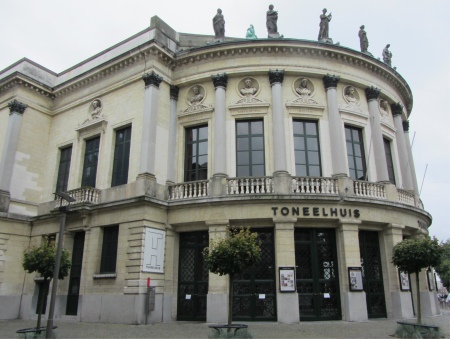
Tonheelhuis
|
After Rubens's death in 1640, his second wife, Helena Fourment, continued to live in the Wapper for several years. From 1648 to 1660, she rented the house to William and Margaret Cavendish, who had moved to Antwerp during the English civil war. They set up a riding school in Rubens's former house and it attracted visitors from far and wide. When the Cavendishes left in 1660, Rubens's heirs sold the house. The building is believed to have retained its original appearance until the mid-17th century, at which point it was fundamentally altered. It was restored to its likely original state after the City of Antwerp purchased it in 1937. Later on, after renovation, the former residence of Rubens was opened as a museum. In reality, only the porch and the garden pavilion were the more or less only intact survivals of the 17th century complex. The works that made up Rubens's art collection were now spread around the world.
I entered the Rubens House in the way Rubens intended: through the main portico that lead to the elegant inner courtyard. I paused to look at the elaborate design of the Italian gable and the Baroque portico, which were in sharp contrast to the traditional building style of the 16th century residence. The impressive portico, designed by Rubens himself, revealed the artist's fondness of classical antiquity and Italian art, and was in need of restoration. Until such time, a wooden structure was in place, supporting the top part of the portico. The portico was one of the few original elements left from Rubens' time.
Before entering the museum proper, I walked under the portico into the garden. During the restoration that took place in the 1940's, the garden of the Rubens House was completely re-laid. For the large decorative elements, such as the fountain, the wooden doors, pavilion and the pergola, the garden architect was able to refer to paintings of Rubens and his surroundings from visual sources such as Rubens' painting, "Wandeling in de Tuin" (Strolling in the Garden), horticultural data and botanical works. In 1993, the garden was given a face-lift and the style of the late renaissance was taken even further. The Rubens Garden was a rare example of this style. It was also certain that newly discovered plants were present in the garden, such as the sunflower, tulips, the fritillary and potato plants, which were imported as decorative plants from the New World. Orange, fig and other fruit trees were also to be found here.
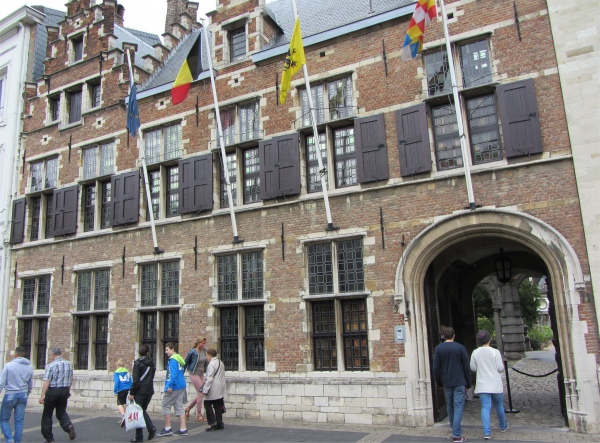
Rubenshuis on the Wapper
|
The Rubenshuis housed a collection of paintings, some by Rubens himself, some by his contemporaries and apprentices. The paintings were displayed throughout the house. I entered the museum via the parlour, and immediately latched on to two prints by Jacob Harrewijn, the oldest known pictures of the house. They were commissioned by the then-owner, the canon Hendrik Hillewerve, who wanted to showcase the house's most impressive features. The additions designed by Rubens - the portico, the studio, and the garden and pavilion - figured prominently; the rest of the property was literally left in shadow. These prints formed the basis for the building restoration undertaken in the 1940s. I was amazed at how much space there was surrounding the house in those early times, almost like a country estate. A door took me into the kitchen, dominated by a large open hearth in late-Gothic style. The walls were decorated with tiles showing animated scenes. All kinds of kitchen utensils, such as jugs, pots and majolica made it fully equipped.
Smartly stepping through the serving room, I arrived into the dining room, I came eye to eye with Rubens. In comparison with his North-Netherlands contemporary, Rembrandt, Rubens painted remarkably few self-portraits. Rembrandt painted around forty; Rubens just four. Another difference with Rembrandt is that Rubens always presented himself in his self-portraits as a confident and distinguished gentleman, never as a painter. The other three self-portraits were painted by Rubens as commissions or were intended as gifts. The painting in the Rubens House was probably intended for use in the studio, as a model which his assistants could copy. This painting is traditionally dated around 1630. Rubens was then fifty-three. Besides his famous self-portrait, the portrait of his second wife, Helena Fourment, also hung here.
Adjacent was the Kunstkamer (art room). Like other wealthy Antwerp citizens, Rubens was a passionate collector. His art collection was the biggest in 17th-century Antwerp. The large part of his collection consisted of classical sculpture and Italian and Low Countries painting. For example, he owned a collection of antique sculptures as well as major works by Titian and Van Dyck. Most of Rubens' collection was also exhibited in his time in this impressive art gallery. In all probability, his art room looked very much like the one that appears on the elaborate painting of Willem Van Haecht. The canvas shows the collection of the rich merchant, Cornelis van der Geest. What is so remarkable about this painting is the enormous number of canvases that are displayed in the room together with other objects such as sculptures, drawings, coins, books and measuring instruments.

Elegant Inner Courtyard, Original Portico in the Centre
|
A flight of stairs took me up to the master bedroom, though no articles remained to indicate it had been a bedroom. It was given this name in the assumption that this was where Rubens slept, and according to tradition, the artist died here on 30th May 1640 following debilitating attacks of gout. In the small bedroom next door, the most striking picture that caught my attention was that of a young boy on his death bed. With the high infant mortality, parents often did not have the chance to have their child pose for a portrait in life. In that case there was always the option of commissioning a portrait after the child's death. The child in this portrait was probably a boy, given the length of the hair. In his right hand he was holding a branch of laurel to protect him from evil spirits, while his left hand clutched a flower. Individual cut flower buds symbolised an early death, and the image was used in poetry of the period as well as painting.
Passing through a door brought me into the linen room. Linen was a major part of a woman's dowry and was considered a status symbol, a visible sign of the family's prosperity. One of the most important duties of the lady of the house was to take care of the linen and ensure that it was properly stored. The linen cabinet and linen press therefore occupied a prominent place in the interior of any home. The linen was generally washed and bleached outside. After it had dried, it was starched and ironed on an ironing table covered with a soft woollen cloth. Finally, the carefully folded linen was fed into a heavy linen press and formed into a pattern. In the 17th century, meals were never had without a tablecloth. Its quality, the pattern and the visible folds were indicative of the wealth and status of the family. These folds were made by the linen press, which had a prominent place in the 17th-century household.
